Old-growth forests, also known as primary forests, have withstood the test of time. Against all odds, they make up about 34% of the world's forested land and are considered old-growth because they have remained intact with no signs of human invasion or obstruction. Their valuable resources, mainly lumber, have been pursued by loggers for years as environmentalists fight to keep these ecosystems untouched. As a home for various thriving and endangered plants and animals, destroying these ecosystems could lead to habitat loss, biodiversity, and an increased carbon footprint. Deforestation, or the harvesting of forested land as a resource, raises concerns over the health of these lands and their future effects on climate change. Let's dive into the characteristics of primary forests and the biodiversity within to understand the potential consequences of destruction.

What differentiates a primary forest from a secondary forest is that it "has attained great age without significant disturbance, and thereby exhibits unique ecological features, and might be classified as a climax community." A climax community means reaching a sense of equilibrium through the cohesion of plants, animals, and fungi in a shared environment, finding ways to grow and thrive off each other. In contrast, secondary forests are regenerating due to forest fires, infestation, or harvesting, and this regeneration process can vary in time. Old-growth is often defined depending on its geographical location. For example, Hardwood forests in the eastern U.S. develop old-growth characteristics in 150-200 years, while in British Columbia, old-growth is considered 120-140 years due to common wildfire occurrence. In contrast, British Columbia's old-growth rainforests on the coast are around 250 years old, with some trees reaching more than 1000 years of age.
Aside from age, a unique combination of characteristics creates a thriving ecosystem within old-growth forests that differentiates them from a typical forest. Organisms within these ecosystems go through an infinite cycle of death and rebirth and have high biodiversity. Biodiversity refers to the variety of life within a habitat or ecosystem. Primary forests are the perfect breeding ground for rare, threatened, and endangered species to flourish as they are unaffected by negative human impact. They show distinction with their mixed-age tree stands, pit and mound topography, standing snags, decaying ground layer, intact soils, and a fungal system, all of which work together to create a healthy ecosystem. In greater detail:
- Pits and mounds- roots create holes in the ground when pulled up by tree fallings, and decaying fallen trees cause mounds.
- Standing snags- dead or dying trees serving as a food source and habitat for animals
- Soil has "soil profiles"- where physical, chemical, and biological characteristics provide a space for organisms to survive with varying needs.
- Carbon-rich organic matter- within the ground layer of the forest floor is courtesy of fallen trees, and wooden debris provides a substrate for mosses, fungi, and seedlings.
- Layered canopies- a thick layer of overlapping leaves and branches formed by closely spaced trees
- Canopy gaps- areas where the light shines through, allowing for some regions of the forest to live in the light, leaving other parts left in the dark
Microhabitats form and thrive within different environments provided by the layered canopies and variation among the forest floor. In combination, various attributes are necessary for the survival of an old-growth forest and its organisms.

Primary forests' rich biodiversity shows the importance of balanced ecosystems. According to Dr. Noah Greenwald at the Center for Biological Diversity, "loss of species biodiversity, even uncommon species, has real economic costs. Species pollinate most of our crops, control pests, provide food, create soils, and are a major source of medicines and other useful products." Understanding what builds upon biodiversity within a system is essential to see the whole picture. In an ecosystem as big as a primary forest, the characteristics that differentiate old-growth from a secondary forest create a unique ecosystem worth protecting.
.jpeg)
The destruction of Old-Growth Forests due to deforestation and the harvesting of lumber could exponentially increase greenhouse gas emissions due to the large amounts of carbon stored above and below the ground. Sarah Ruiz at Global Forest Watch says, "It is estimated that tropical primary forests alone store over 141 billion tonnes of carbon." The release of carbon during logging and deforestation increases the risks of climate change and prevents natural resources from providing for plants and animals. It also reduces the capacity for primary forests to sequester more carbon in the future. Losing biodiversity within these ecosystems would affect the planet as a whole. Plant and animal health is essential for the well-being of humans and could prove invaluable for curing ailments. The preservation of these forests also protects cultural diversity, ensuring that traditional, indigenous ways of life are not disrupted. As economists and environmentalists weigh the pros and cons of the loss of primary forests, it is necessary to understand deforestation's current and long-term effects as climate change rises.

Do your part to save old-growth forests, visit:
Why Old-Growth Forests? - Old-Growth Forest Network
Learn More:



